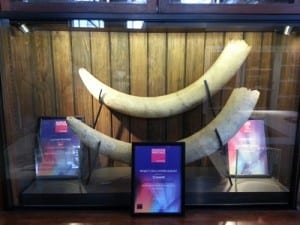Tiny Praise for the Micrarium at the Museums + Heritage Awards
By Jack Ashby, on 15 May 2014
Last night was the Museums + Heritage Awards – the Oscars of the Museum world. This was our third year on the shortlist, and after winning the Award for Innovations in 2012 and the Guardian Cultural Pros Pick (a public vote to find the UK’s most inspiring museum) in 2013, hopes were high that the Micrarium (our place for tiny things) would pick up the Award for Project on a Limited Budget in 2014.
Sadly that wasn’t to be, but happily we didn’t come away empty handed. We were the Highly Commended entry in the category, so we do have something to add to the trophy cabinet. We are really thrilled that the project was recognised by the sector.
The Micrarium was conceived to overcome two identified problems in museums with natural science collections. First, that 95% of all known animal species are tiny – smaller than your thumb – yet nearly all the specimens on display in natural history museums are large animals. As such, natural history museum galleries are deeply unrepresentative of the natural world – a disconnect that visitors very rarely notice.
Second, most natural history museums have extensive microscope slide collections (the Grant Museum has 20,000), yet no-one has ever developed a way of successfully using them in displays. Beginning in the 19th century, slides were used as standard in biological research and teaching and were a vital resource up until the 1980s. They have largely become obsolete as reference tools in research and as illustrative tools in teaching because of modern imaging technologies. Their content and physical properties make them very difficult to display. As such microscope slides are largely considered effectively useless. As part of the project we surveyed all UK museums with natural history collections. Other than the occasional decorative drawer adorning a biographical case, or a handful in fixed microscope interactives, not a single museum had found a way to display them or use them with audiences.
The Micrarium is one solution to both of these issues.
If you haven’t seen it, it is arguably the most beautiful 2.52 square metres in London.
The winning entry was Haslemere Educational Museum for their 125th Anniversary Campaign. Very many congratulations to them.
The next step is to work out what we have to do to get the Guinness Book of World Records to confirm that the Micrarium contains the most museum objects per unit area than anywhere else. Watch this space.
As we didn’t get to do it last night in an acceptance speech, let me take this chance to say thank you from everyone at the Grant Museum to the designer Thomas Haynes; Valerie Cooper in UCL Capital Projects who coordinated all the contractors; everyone who helped build it, and all of the visitors who keep saying “wow” as they walk in to it (my office is on the balcony above the Micrarium – I CAN HEAR YOU) and tweeting great pictures of it.
Jack Ashby is the Manager of the Grant Museum.
3 Responses to “Tiny Praise for the Micrarium at the Museums + Heritage Awards”
- 1
-
2
Rebecca Twiston-Davies wrote on 19 February 2021:
Hello there,
I am an MA student (MA Art and Design in Education) at the IoE, currently working on a module called ‘Artefacts as an Educational Resource’. I would dearly love to visit The Micrarium but sadly it is not possible at the moment. It has really captured my imagination as an educational resource, it has so much potential as a concept and as a way of engaging with artefacts that we may not usually see.
I wonder if you can tell me whether you hold slides showing samples of skin?! I am working on a collaborative group project and we are considering the senses, particularly touch. As an artist-teacher I am thinking of ways I might respond to The Micrarium….would you consider out-reach projects with local schools, the potential to curate The Micrarium with young people? Best wishes,
Rebecca -
3
Lisa Randisi wrote on 16 April 2021:

Hi Rebecca,
Thanks for all your enthusiasm! We’d be happy to have a chat about your ideas – please email us at museums@ucl.ac.uk
Best wishes,
Lisa
 Close
Close





Congratulations on the “Silver Medal” and on a great post. As someone who worked on small organisms, I think the Micrarium is a great idea and it deserves to be very popular with Visitors to the Museum.